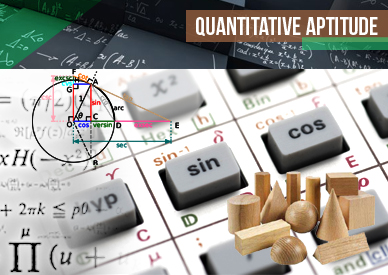Target SBI PO : Day 10 Aptitude : Quadratic Equation New Pattern Questions
Want to Become a Bank, Central / State Govt Officer in 2020?
Join the Most awarded Coaching Institute & Get your Dream Job


Now Prepare for Bank, SSC Exams from Home. Join Online Coure @ lowest fee
Lifetime validity Bank Exam Coaching | Bank PO / Clerk Coaching | Bank SO Exam Coaching | All-in-One SSC Exam Coaching | RRB Railway Exam Coaching | TNPSC Exam Coaching | KPSC Exam Coaching
Target SBI PO : Day 10 Aptitude :
Quadratic Equation New Pattern Questions
D.1-5) In the following question two quantities are given Quantity 1 and quantity 2 By solving those quantities give corresponding answer.
Q.41) Quantity 1:Two varieties of wheat are mixed together while the first variety is of 90% pure wheat and the rest contaminants and the other variety having wheat and impurities in the ratio 8:3. Find the proportion of the new mixture thus formed?
Quantity 2:A milkman indulges in adulteration. He mixes water in the milk in the first container. After mixing, the respective ratio between water and milk is 1:7. He pours the mixture in another mixture containing 85% milk in the second container. What is the respective ratio between the milk and water in the second container?
- a) Quantity 1 ≥ Quantity 2
- b) Quantity 1 = Quantity 2 (or) No relation
- c) Quantity 1 > Quantity 2
- d) Quantity 1 ≤ Quantity 2
- e) Quantity 1 < Quantity 2
Q.2) Quantity 1:The speed of a car is two times the speed of a train of length 250m crossing a bridge of 350m in 24 seconds. What is the speed of the car in kmph?
Quantity 2:Two trains of length each 500m cross each other in 12.5 seconds travelling in opposite directions. One of the trains crosses a pole in 10 seconds. What is the speed of the slower train?
- a) Quantity 1 ≥ Quantity 2
- b) Quantity 1 = Quantity 2 (or) No relation
- c) Quantity 1 > Quantity 2
- d) Quantity 1 ≤ Quantity 2
- e) Quantity 1 < Quantity 2
Q.3) Quantity 1:Ram invests some amount in scheme A for 3 years at a rate of 5% simple interest. He also invests in scheme B Rs.2000 more than what he invested in scheme A for 2 years at a rate of 6% simple interest. If he gets a total of Rs.1050, then what is the total amount he invested in both the schemes?
Quantity 2:An amount is received by a person at the end of 2 years with a compound interest amount of Rs 615. The interest amount is 10.25% of the principal amount. If the same person receives Rs 768.75 in another scheme for same period and at the same rate, what is his first time investment?
- a) Quantity 1 ≥ Quantity 2
- b) Quantity 1 = Quantity 2 (or) No relation
- c) Quantity 1 > Quantity 2
- d) Quantity 1 ≤ Quantity 2
- e) Quantity 1 < Quantity 2
Q.4) Quantity 1:A cube is melted so as to cast several cubes of length of side 2m. The ratio of the length of side of older cube and the newer cube is 3:1 respectively. What is the no of cube so formed?
Quantity 2:
A person jogs around a circular park of diameter 210m. He aimed to cover 6.6kms. How many rounds he has to go to cover the distance?
- a) Quantity 1 ≥ Quantity 2
- b) Quantity 1 = Quantity 2 (or) No relation
- c) Quantity 1 > Quantity 2
- d) Quantity 1 ≤ Quantity 2
Q.5) Quantity 1:Hari buys a shirt with 4% discount whose marked price is 2100rs. Still the seller gains 12%. What is the cost price of the shirt?
Quantity 2:A seller allows a discount of 10% on a watch. If a customer buys a pair of watch, then he is offered 4% extra discount. He buys two watches for 960rs. What is the price of two couples of watches?
- a) Quantity 1 ≥ Quantity 2
- b) Quantity 1 = Quantity 2 (or) No relation
- c) Quantity 1 > Quantity 2
- d) Quantity 1 ≤ Quantity 2
- e) Quantity 1 < Quantity 2
D.6-10) In the following question two quantities are given Quantity 1 and quantity 2 By solving those quantities give corresponding answer.
Q.6) Quantity 1:A boy is 4 years older than his brother. After four years from now the boy’s age will be two times his brother’s age after 2 years. What is the ratio of their age 3 years later from now?
Quantity 2:The average age of a family consisting a father, a mother, two boys and the youngest girl child who is 4 years younger than one of her brothers and 2 years younger than another brother is 21. The difference between the ages of mother and father is 5 years. The ratio between the ages of parents and the children is 5:2. What is the ratio between the ages of mother and her girl child if father is the eldest in the family?
- a) Quantity 1 ≥ Quantity 2
- b) Quantity 1 = Quantity 2 (or) No relation
- c) Quantity 1 > Quantity 2
- d) Quantity 1 ≤ Quantity 2
- e) Quantity 1 < Quantity 2
Q.7) Quantity 1:
Which of the following is greater?
4/15,5/17,10/33 and 8/27
Quantity 2:Which of the following is greater?
6/13,7/15,13/19 and 31/50
- a) Quantity 1 ≥ Quantity 2
- b) Quantity 1 = Quantity 2 (or) No relation
- c) Quantity 1 > Quantity 2
- d) Quantity 1 ≤ Quantity 2
- e) Quantity 1 < Quantity 2
Q.8) Quantity 1:
What is the probability that two cards drawn in random from a deck of cards to be a multiple of 5 or ace?
Quantity 2:A man wants to choose a shirt from his almerah if it contains 2 blue shirts, 3 green shirts, 5 yellow shirts. What is the probability that the shirt is not an yellow shirt?
- a) Quantity 1 ≥ Quantity 2
- b) Quantity 1 = Quantity 2 (or) No relation
- c) Quantity 1 > Quantity 2
- d) Quantity 1 ≤ Quantity 2
- e) Quantity 1 < Quantity 2
Q.9) Quantity 1:
Two persons A and B started a business in which A invests some money and B invests 4000 more than what A invests. After three months from the start of the business A invested an additional amount which is one fourth of the amount he invested in the beginning. At the end of one year they earn profit in the ratio 57:80. What is the amount invested by the person B?
Quantity 2:P can finish a work in some days where Q takes two times the time taken by P. The efficiency of R is three times the efficiency of P. All the three persons are given a work and the sum of their wages will be Rs 8550. What will be the wage of B?
- a) Quantity 1 ≥ Quantity 2
- b) Quantity 1 = Quantity 2 (or) No relation
- c) Quantity 1 > Quantity 2
- d) Quantity 1 ≤ Quantity 2
- e) Quantity 1 < Quantity 2
Q.10) Quantity 1: Pipe A can fill a tank in 36 hours while pipe B can fill it in 24 hours. If both the pipes are opened for an hour alternatively starting with A, then in how many hours the pipe will be filled?
Quantity 2:To a cistern, three pipes namely A, B and C are attached. Pipe A can fill the cistern in 12 hours, pipe B can fill the cistern in 15 hours and pipe C can empty the cistern in 20 hours. In how many hours the cistern will be filled?
- a) Quantity 1 ≥ Quantity 2
- b) Quantity 1 = Quantity 2 (or) No relation
- c) Quantity 1 > Quantity 2
- d) Quantity 1 ≤ Quantity 2
- e) Quantity 1 < Quantity 2




1 comment
For 9,quantity 2 answer should be 450 right??